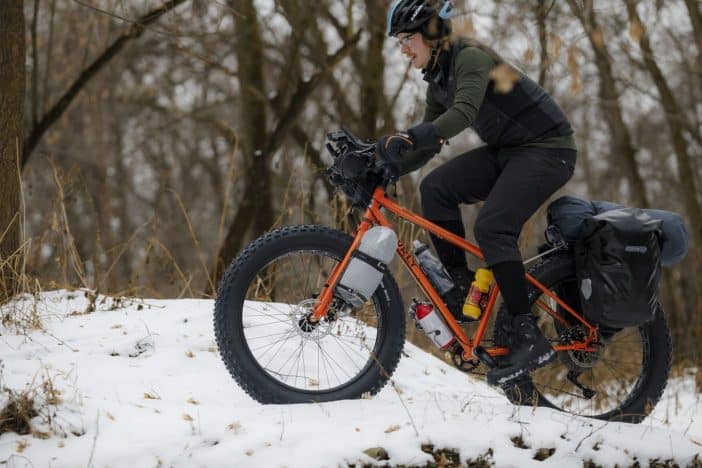As I write this blog post I have been looking for a fat bike to take across the Canning Stock Route in Western Australian. For context I am planning my most epic and chllenging bike tour as of recent. I will be riding from Perth to Darwin via the Canning Stock Route. This route is tough, well I mean sandy and very sandy at that. Requiring nothing less then a fat bike to get the job done.
I wanted to see what all the options are out there for adequate fat bikes that will be able to get the job done for me. I have been researching and asking other fat bike tourers about their bikes and what they recommended from experience. In this blog pot I have compiled a list of all the fat bikes that I will be looking at for my bikepacking adventure across the Australian Outback.
So quickly here are the best fat bike for bikepacking that we will be looking further into.
- Surly Big Fat Dummy
- Surly Pugsley
- Surly Ice Cream Truck
- Surly Wednesday
- Salsa Blackborow GX Eagle
- Salsa Mukluk SX Eagle
- Muru Cycles Fat Bikes
- Tumbleweed prospector
So lets get into some of the best fat bikepacking bikes. The ‘best’ bike really comes down to what type of riding you intend to do with a fat bike. Are you going on tail type bikepacking trips for a few days? Or are you going on hard to get to, sandy or even snow terrain, bikepacking or touring expeditions? For months on end? The majority of these bikes are better suited to trail fat biking. While others are best for those epic adventures that needs a reliable bike, that is designed, for example with a longer chainstay that will work best with a rear rack and panniers for carry extra gear that you may need.
Also I get it, price, it is another factor when looking for the right fat bike. Some of the bikes in this list are very expensive for a bicycle. But if that is not in your budget range and you are just looking for something more entry level but still fall under the ‘best’ category and are recommended by other bikepackers. There are some options that cost around that $1,500 USD range.
*If you want to buy any of these fat bikes, doing it via the affiliate links give Cycle Travel Overload a small commission which goes into creating more great resources for the bike travel community.
Surly Big Fat Dummy

When looking for the ideal fat bike, I have considered a couple cargo fat bikes. As these are great for carrying extra loads in the very remote corners of the world. This Surly Big Fat Dummy has been recommended to me by many people and I love Surly bikes they make quality stuff. I have the Surly Long Haul trucker and it is a work horse.
The mashing of a cargo bike and fat bike together just makes perfect sense. From a adventure bike stand point this opens up huge possibilities, with the type of terrain and how remote you can really go! Especially as a solo traveler with no support crew you could get into very deep, untouched places and be self sufficient on such a bike due to the load capabilities then you may not be able to on a standard touring bike.
The bike has so many triangles and it looks so epic. You will be able to fit the largest tire options at probably 5.25″ or 13.3 cm. Surly as say that this bike is able to be a trail building bike. Allowing you to cart a chainsaw and shovels and all that gear. It is such a versatile machine!
Quoted by Surly they call the Big Fat Dummy a “fat-tire, long-tail cargo bike that took a few too many growth hormones”. The hauling abilities of this big is what the real appeal is, perfect for the type of maximalist bikepacking I have planned for it. The newer Dummy bags are easily twice the size of the old ones, swallow massive amounts of cargo and can be configured in many ways to accommodate bulky and odd-shaped cargo.
I really wanted to figure out if this bike was as good as some have said, So I tried to find any pitfalls or things people didn’t like about the Big fat Dummy and see if that would impact my decision in buying one or not.
It seems size and weight could be a potential issue for some people. I manage to pick up a cumbersome 30kg fully loaded touring bike, but I am not sure how I would go with a bigger and bulkier bike to manoeuvre. This could be a potential issue. It is a longer bike and storage space, not that it is a issue for me it is something to consider if you live in a apartment.
Other then that the bike seems like a great option. I am glad it comes with a kick stand as you will need one for practicality. Especially when it is loaded. The bike comes in at a retail price at Surly for $3,025 USD or $4,440 AUD.
Part of me thinks to just hire a fat bike for my adventure. But I feel if I get one to complement my LHT it will interest me to go on other epic bike adventures. Like you know? Maybe Antarctica! Oh, wow I just spent 30 minutes researching another trip idea! Whoops, okay back to writing this blog post!
Surly Pugsley

I did say I love Surly bikes so for now the next few will be the other Surly options that I have been looking into. The Surly Pugsley is a more normal fat bike like the rest of the option when compared to the cargo fat bike of the Big Fat dummy, but you know what that is not really a bad thing. Maybe a bike like these will be better to ride.
This bike is specifically designed to be ridden in sand and snow. Surly call this bike a “ultimate expedition bike tailored for off-road touring and exploration”. This state make me lean more toward this bike for my intended use!
The tires and wheels are custom made by Surly. This bike offers the Surly My Other Brother Darryl (80mm), black, dual hole pattern, Tubeless Ready rims. With Surly Edna, 26×4.3, 60 TPI, Tubeless Ready Tires. You get the clearance for 26″ x 4.8″ tires in the frame (with drivetrain restrictions) and 26″ x 4.3″ tires in the fork.
The design of the bike around the tires is isometrical as it provides that space for the such large tires, due to the large hub size also. As this bike is setup for ‘extreme expedition’, the handlebars are one of the main reasons I like this bike. The Surly Moloko Bar are not like flat bars. They offer a different variety of hand positions which is a must for extended bikepacking expeditions. I have heard some great things about this bars, very happy to see they come with this bike and you get the option for a custom Surly made handlebar bag that wedges inside the handlebar space. Another great thing about this bars is the double bar designs means you don’t need a handlebar extension for handlebar roll packs they can fit directly onto these bars.
The bike has a longer chainstay at the back so there is no worried with heel clearance for panniers for touring. The bike has a offset frame. On the right side of the bike, if you want a rear rack, it has to be placed on the inside of the frame. The recommended rack that does not come with this bike and I will be looking at getting if I was to get this bike, is the Surly Nice rack. On the left side of the bike the rack fits to the outside of the bike which is a little unusual.
The jump from gears sometimes feel somewhat dramatic at times. With a 1X11 setup, the rear cog is a Sunrace 11 speed, 11 tooth at the smallest and 46 on the big. With a Shimano SLX RD-7000 GS 11 Speed rear derailleur.
The bike comes with a heap of mounting eyelets on this inside and outside triangle. Also three eyelets on each fork for mounting cargo cages. So for pricing the Surly Pugsley costs $1,900 USD retail or $2,788 AUD.
Surly Ice Cream Truck

It can become difficult to compare bikes and match the best bike to your personal biking needs. The Ice Cream Truck is a bike that seems better for trail riding and not so when it comes to bikepacking expeditions. But having that said I don’t see how it would not hold up.
The thing that stands out and I love most about this bike is probably that it comes in a fresh pink colour. It looks so cool! Again as quoted by Surly, the Ice Cream Truck is a “bike we reach for when we don’t really know what the trail has in store”.
But the selling point I guess you would say for this bike is that it is the largest tire clearance option for steel frame fat bikes on the market. It comes with Surly Bud & Lou, 4.8″, 120tpi tires. The bike has the possibility to have a clearance for a full 26” x 5” tire on 100mm rims. Not including the Big Fat Dummy as it is a cargo bike and fat bike hybrid with the potential for a clearance for 26″ x 5.25″ tires or 29” x 3.0” tires. (sorry I am not sure I mentioned the BFD tire specs earlier).
It seems like this bike is more suited to someone looking for a bikepacking rig that can master mostly bikepacking trails and challenging singletrack sections. It has modern trail bike standards like the stealth dropper post routing, 44mm headtube, and thru-axles.
It might not be the best option for panniers thanks to a shorter chainstay. The bikes geometry is designed with tight and fast maneuverability in mind on technical terrain. it also has a long toptube and a 68-degree headtube angle to help make it feel more racy.
For pricing this bike comes in at a flat $2000 USD from Surly or $2,934 AUD.
Surly Wednesday

The Surly Wednesday is a cheaper fat tire trail bike option in comparison to the Ice Cream Truck. Surly have categorised this bike as a mix between a trail bike and a touring bike. Mentioning that it is “a great all round fat bike that has the soul of a trail bike and a mind of a touring bike.” The Wednesday is a bike that fits in the middle between the Pugsley and the Ice cream Truck.
It has the finer riding qualities with thinner inner tubing like a Pugsley has. And it has the trail geometries like a Ice Cream Truck. It is a little lighter and not a stiff as the Ice Cream Truck. The Wednesday has a slightly shorter for and thinner tubing. Comes with Surly Nate 26 x 3.8˝, 60tpi, tubeless ready tires and the capacity to have a 26 x 4.6” tire clearance.
The bike also has those modern mountain standards. Like the stealth dropper post routing, 44mm headtube, suspension correction, front and rear thru-axles. The bike also has that little bit shorter end (435 chainstay), giving it a playful feel compared to a longer Pugsley chainstay length (460).
This might be a option for some who are looking for a fat bike for bikepacking, due to its affordability. Prices come in at $1,550 USD from Surly or $2,271.50 AUD
Salsa Blackborow GX Eagle

The Blackborow is the other cargo and fat bike hybrid option that I was considering for a potential fat bike. It was recommended but it seems that the Surly is the better bike. Again considering sand and snow type terrain this bike is best suited. With a extra long wheelbase like the Dummy, that means incredible stability and tracking in soft loose terrain and extra storage.
But, when it comes to the cargo load capacity, this Blackborow is limited to 185 pounds and the Dummy can carry up to 200 pounds of gear. (81.5 kg and 90.7 kg) Which is both more then enough for most, if not all bike adventurers.
Both the Surly and this Salsa do come with rear racks which is great, the Surly also has pannier bags too which the salsa does not. That is not a deal breaker as you could just use the pannier you might already have from other touring bikes like me. But maybe you want speciality design cargo panniers, unfortunately the Salsa doe snot include them with the bike out of the box. If you wanted you could take advantage of the Salsa’s huge carrying capacity via abundant frame and fork braze-ons, and there is also room for four full-sized panniers on the rear rack.
The price for this Salsa Blackborow bike is $3,299 USD ($4,823.50 AUD) retail at Salsa or you can pick up one for a discounted price at REI for 2019 model at $2,479.83 but from what I understand that is limited stock and availability may run out. When comparing prices of the Surly and Salsa cargo fat bikes the Surly Big fat Dummy is $74.00 cheaper and it just seems like a more capable bike compared to this Salsa.
Also when comparing the Big Fat Dummy and the Blacborows chainstay length. You will notice that the BFD has a much longer length at 875 mm which is 225 mm longer then the Salsa Blackborows Chainstay.
Salsa Mukluk GX or SX
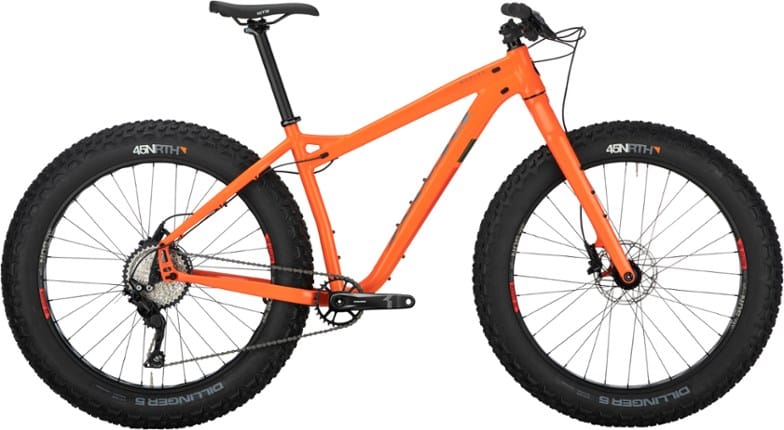
The other Salsa in this list is there most recommended fat bike option. The Mukluk SX Eagle is the new 2020 release. They also make a later GX model. The GX being a carbon fibre fat bike and much more expensive. Aluminum is still a strong bike frame material and for me if I was to choose between the two it would be the SX Eagle.
They say that the Salsa Mukluk SX 2020 Fat bike is Salsa most versatile yet. Designed and engineered to excel in the wide variety of conditions. The bike is able to accommodate up to 5″ tires with the help of 197mm rear spacing on the frame. The 100mm threaded bottom bracket allows a wide range of crank (Q-factor) choices too.
The Mukluk SX has alternator 2.0 dropouts which allow for some of the shortest chainstay lengths available. Meaning that you can run a single-speed or geared drivetrain setup.
If you want a rear rack on this bike, which I am not sure how the fit would go with the shorter chainstay. The bike is compatible with Salsa Alternator 190 Rear Rack using Salsa Rack-Lock seat collar.
The bike looks very sleek with the internal cable housing routing. And it comes with stealth dropper post routing and 1x or 2x drivetrain compatibilities.
Also the Bearpaw Carbon fork features two sets of Three-Pack mounts, and 15 x 150mm thru-axle. The bike costs $1,999 USD at Tree Fort Bikes or $2,923 AUD.
Muru Cycles Fat Bikes

Muru Cycles is a Australian brand that make 5 different fat bike options. If you are in Australia it might be worth checking them out. Each frame has unique features and each has it’s own special reason for being in their range. So let’s look at them.
Muru has two categories that either of the their bike choices fall into and sometimes a bike can fit into both.
Overlander : “rated frames and bikes are our expedition level models. The geometry has been optimised for long days in the saddle and expedition style riding. Typically they run rigid forks and are designed for adventure and all terrain use.”
Trail : “Rated frames and bikes are intended more for singletrack and trail riding. (regular mountain biking) The geometry will be a little snappier. They are usually designed around fitment of a suspension fork. (the exception being the Mungo)”
But having that said it is not like you need to get a ‘Overlander’ if you wish to go on a expedition trip, you will probably be fine with a trail model. But the bikes in each category are designed to be more suited to these types of riding.
Muru sell framsets and are custom made from titanium.
Witjira overlander fatbike frame
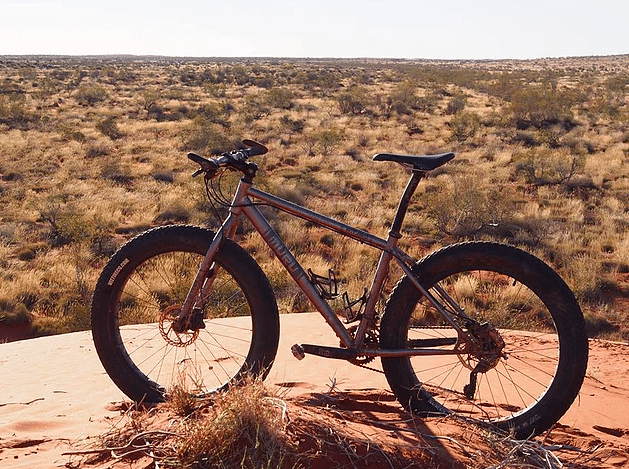
The Witjira is the end result of countless klms ridden on varied terrain. Sand, snow, singletrack, fireroads and some very long days in the saddle.
Muru Cycles
The Witjira was the original model in our range. As the frame that started Muru on our way, the Witjira has a special place in our hearts. It’s also very versitile. The 170mm rear spacing also lends itself to the new Rohloff XL rear internally geared hub. As the original frame in our “Overlander” range, the Witjira is most at home on remote beaches, outback trails, and tracks.
Muru Cycles
Named after Witjira National Park in Central Australia and designed to deal with all terrain. Proven on the real world of the Iditarod Trail Invitational in Alaska and the Simpson Desert Bike Challenge in Australia.
Muru Cycles
Witjira trail fatbike frame
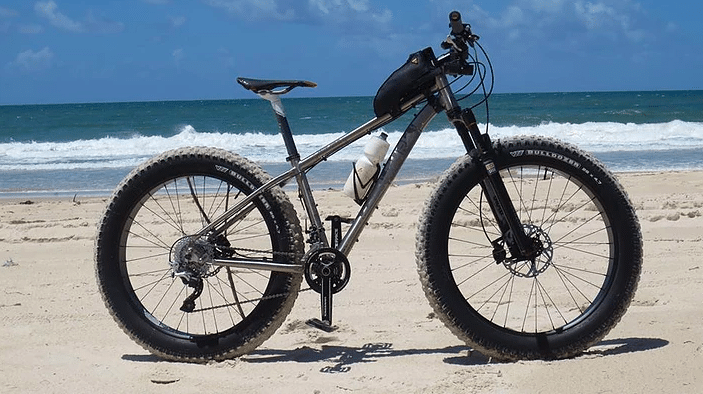
The Witjira Trail is a direct result of ongoing development of the original V2 model. Refined tubing specification and updated geometry has lead to the frame you see here.
Muru Cycles
Trail features
1) We’e adjusted the front end geometry to better suite a 511mm axle to crown. (to suit the new Rockshox Bluto fork @ 120-100mm)
2) At the same time we’ve changing the downtube to reflect the new front end. We’ve borrowed the downtube from the Mungo. It’s custom worked to provide more welding surface at the headtube. This translates to a stiffer front end. Which is just fine when you’re running a suspension fork.
3) Muru rocker rear dropouts are now standard
Since we’ve made so many changes, we didn’t feel that the old V2 name was accurate any more.
So the “Witjira trail” was born.
The Witjira range are named after Witjira National Park in Central Australia and designed to
deal with all terrain.
Tanami trail fatbike frame
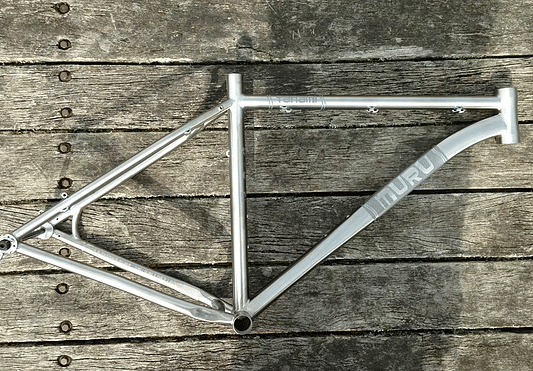
The Tanami trail has been developed to give you the best of both worlds. The massive 197mm rear spacing and tyre clearance of the Tanami, combined with geometry that has been adjusted to take full advantage of the Rockshox Bluto and Manitou Mastodon suspension forks.
Why 197mm?
The Tanami brings 197mm rear spacing and a 100mm BSA (threaded) bottom bracket to the Muru family. Why 197mm? The answer is that as tyres and rims get wider, demands for clearance in the rear get tighter and tighter. Chain, tyre, chainline… they’re all fighting for space. The 100mm BB spacing means that you can chuck a 4.8″ tyre on a 100mm rim in the back with less compatibility issues and no need to build the rear wheel offset.Muru Cycles
“Trail” specific features
1) We’re adjusting the front end geometry to better suite a 511mm axle to crown. (if you want to run a 5.05″ front tyre however… you’ll need to look at the Manitou Mastodon Pro).
2) At the same time we’re changing the downtube to reflect the new taller front end. We’re borrowing the downtube from the Mungo. It’s custom worked to provide more welding
surface at the headtube. This translates to a stiffer front end. Which is just fine when
you’re running a suspension fork.
3) 197 x 12mm thru axle rear.
The Tanami is named after the Tanami desert in Central Australia and designed to deal with all terrain.
Canning adventure fat frame
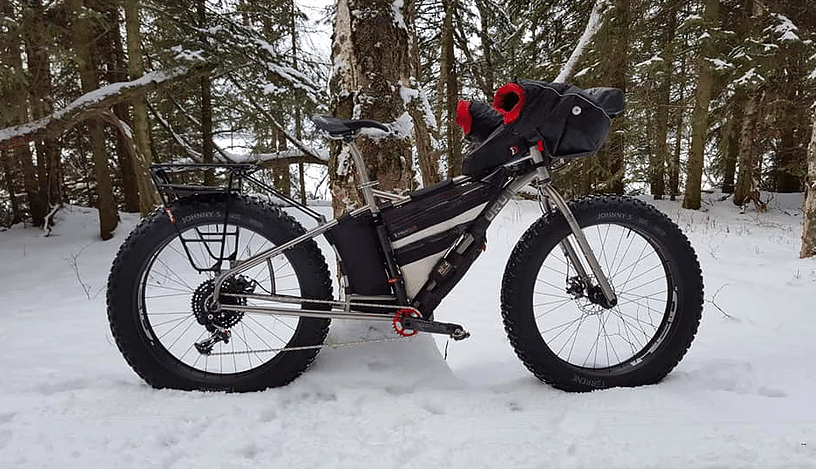
The all new Canning has been developed from the ground up to optimise equipment hauling capacity and floatation on soft terrain.
Muru Cycles
Why?
Since we already offer the Witjira range that run tyres from 4.0″ up to 4.7″ (on up to 80mm wide rims) and the Tanami models that happily run 4.0″ up to 5.05″ tyres (on 100mm wide rims).
So whats with the all new model? Simple. The new range of *actual* 5″ tyres like the Terrene Johnny5 and Vee Tire Co Snowshoe 2XL 5.05″ have changed the way we think about floatation. It’s changed the whole concept of remote travel and the ability to take adventure equipment with you.
But just being able to fit 5″ tyes, (on a 100mm wide rim) in the back of a Tanami (V2) just wasn’t enough. Because in certain situations we need to be able to carry more. More food, more water, more gear.
The Canning is named after the Canning Stock Route in Central Western Australia.
FEATURES
1) We’e adjusted the front end geometry to better suite a 483mm axle to crown. This allows for clearance on massive 5″ tyres.
2) At the same time we’ve changing the downtube to reflect the new front end. We’ve borrowed the downtube from our Trail series frames. It’s custom worked to provide more welding surface at the headtube. This translates to a stiffer front end. Which is just fine when you’re running a such a massive front tyre.
3) But you want to know about the back end don’t you… It’s been extended and custom reinforced to take two sets of std panniers or custom haulage bags. Naturally bottle and bag mounts for days are std.
4) we’re currently finalising a custom rear rack to take advantage of the Cannings hauling capacity. Though many std rear (fat) racks will also work just fine.
5) Muru 197/12mm rear dropouts are standard, but rocker adjustable dropouts are available as an upgrade along with a Rohloff cable guide kit as well.
It just makes sense to get a Canning Adventure Bike for the Canning Stock route, doesn’t it? This bike frame costs $2,399 AUD while all the other Muru Frames cost $1,899 AUD.
Finke offset fatbike frame
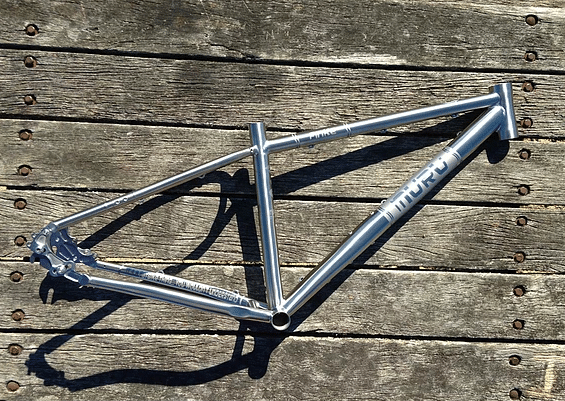
Just like its siblings, the Witjira & Tanami, the Finke is a stunning example of titanium craftsmanship. Designed around a 135mm rear hub and with a 28mm offset frame the Finke allows the use of 100mm rims and 4.8″ tyres.
Muru Cycles
Tumbleweed Prospector

The Prospector! isn’t it just a good looking bike? I think it looks beautiful! It is a popular bikepacking bike with many bikepackers and also for races like the Hunt 1000. Made in Boise, Idaho you can find these for sale in a framset all over the world and in Australia if you are looking for one to build up into your dream rig!
One of the key features with this bike is its bottom bracket. The width is the same as a standard mountain bike. This will be of comfort for many days in the saddle. As many fat bikes create problems with hips and legs being splayed further open and this can just reduce pain that may arise from riding a fat bike for too long.
The Prospector handles more like a mountain bike and less like a touring bike that is build more so to handle weight. But this bike also is build to hold weight in the form of gear for bikepacking. The price starts from $1,450 USD.
